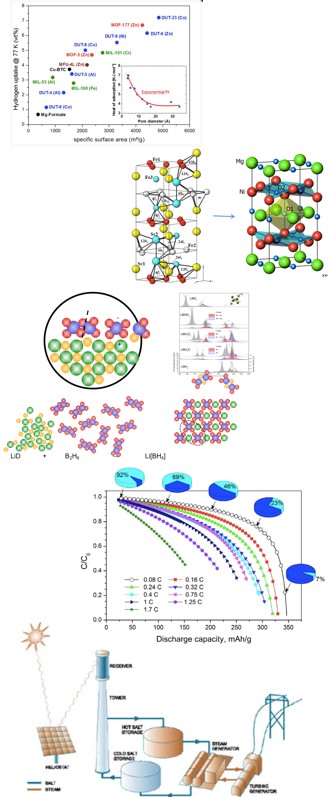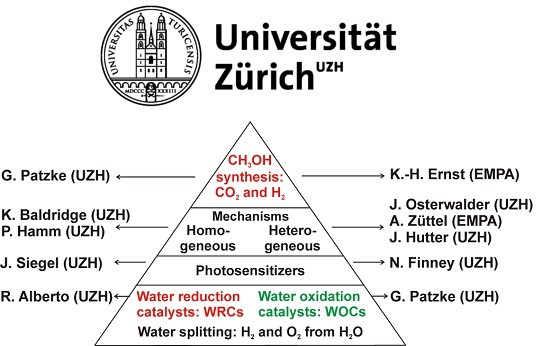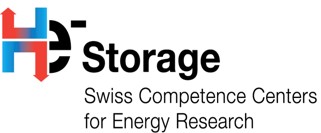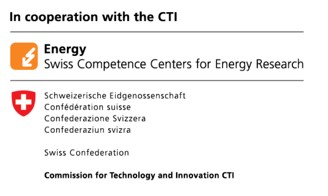International Energy Agency (IEA) Task 32: H2 Based Energy Storage
 |
Task 32 addresses hydrogen-based energy storage by developing reversible or regenerative hydrogen storage materials. In these materials, the quantitative targets for hydrogen capacities vary significantly depending on the different applications, e.g. the gravimetric density is crucial for mobile applications whereas in stationary systems it plays a minor role. Therefore, for each specific application the targets related to volumetric density, thermodynamics, kinetics, cost and safety are totally different. The fundamental understanding of hydrogen storage mechanisms is the key for a breakthrough in the development of materials with improved properties. The focus is on hydrogen in solid compounds approached by experimental, engineering and modeling (both scientific and engineering) activities. At present, Task 32 consists of 48R&D projects lead by project leaders from the participating countries. Most involve international collaboration, which is strongly encouraged. The projects are divided into five working groups:
|
| Participants: HAUBACK Bjørn, Michel Latroche, Cantelli Rosario, DORNHEIM Martin, Shih-Yuan Liu, JENSEN Torben René, JENSEN Craig M., Jose Bellosta von Colbe, Terry Udovic, Tom Autrey, Don Anton, BOOK David <[email protected]>, STERIOTIS Theodore, CHAHINE Richard, DAM Bernard, Tejs Vegge, Maximilian Fichtner, ORIMO Shin-Ichi, WALKER Gavin, David Grant, KOJIMA Yoshitsugu, DE RANGO Patricia, MILCIUS Darius, Yves Chabal, BARICCO Marcello, Jacques Huot, Ross Keith, Isaac Jacob, Karl Gross, Bill David, ZIDAN Ragaiy, Eugen Rabkin, VAN HASSEL Bart A., Dhanesh Chandra, Björgvin Hjörvarsson, Martin Stahlberg, Stetson Ned, Marco Zoppi, MONTONE Amelia, CHEN Ping <[email protected]>, AKIBA Etsuo, MILANESE Chiara, Tom Gennett, Yartys Volodymyr, DE JONGH Petra, FROUDAKIS George E., NORÉUS Dag, FELDERHOFF Michael, BUCKLEY Craig, Claudia Weidenthaler, Pantelis N. Trikalitis, STUBOS Thanos, Sabrina Sartori, CHO YoungWhan, HIRSCHER Michael, AHN Channing C., Alberto Albinati, Darren Broom, Ian Morrison, Zuettel Andreas Countries: Australia, Denmark, France, Germany, Greece, Israel, Italy, Japan, Lithuania, Netherlands, Norway, Korea, Sweden, Switzerland, UK, USA |
|
EU COST MP 1103: Nanostructured materials for solid-state hydrogen storage
| This COST Action deals with the important topic of energy storage and aims to set up a competitive and coordinated network for Hydrogen (H)-storage materials that stimulates innovative and interdisciplinary research in field of Solid State Hydrogen Storage (SSHS) within European Research Area (ERA). The Action on SSHS in light-weight nanostructured materials aims to contribute to the discovery of novel guidelines and phenomena for the design of advanced SSHS systems. The main ambition of the Action is the development of tailored nanostructured materials by understanding how the H binding energy can be tuned during nanostructuring. This Action contributes to form a critical mass of researchers able to increase cooperation and interaction needed for outstanding R&D and innovation-based growth in research field of SSHS materials. COST is the best mechanism for achieving the objectives of this Action, allowing the organization of meetings, workshops and supporting mobility of participants. Participants: Sara BALS (BE), Andreas ZUTTEL (CH), Viera GARTNEROVA (CZ), Martin DORNHEIM (DE), Gustaaf VAN TENDELOO (BE), Vaclav PAIDAR (CZ), Torben R. JENSEN (DM), Dorthe BOMHOLDT RAVNSBæK (DM), Javier RODRíGUEZ-VIEJO (ES), Marta GONZáLEZ-SILVEIRA (ES), Fermín CUEVAS (FR), Michael HIRSCHER (GE), Tejs VEGGE (DM), Carlos SANCHEZ (ES), Fabrizio CLERI (F), Georgia CHARALAMBOPOULOU (GR), Ádám RéVéSZ (HU), Amelia MONTONE (IT), Marine PONTHIEU (FR), Theodore STERIOTIS (GR), Luca PASQUINI (IT), Darius MILCIUS (LT), Bernard DAM (NL), Bjørn C. HAUBACK (NO), Antonio MIOTELLO (IT), Paolo MAZZOLDI (IT), Marit D. RIKTOR (NO), Jerzy BYSTRZYCKI (PL), Georgeta PREDEANU (RO), Ljiljana MATOVIC (RS), Jasmina GRBOVIC NOVAKOVIC (RS), Monika KWIATKOWSKA (PL), Eniko VOLCEANOV (RO), Sandra KURKO (RS), Kondo-François AGUEY-ZINSOU (AU), Robert A. VARIN (CA), Shivani AGARWAL (IN) |
EU FP7-INFRASTRUCTURES-2011-1 H2FC: “Integrating European Infrastructure to support science and development of Hydrogen- and Fuel Cell Technologies towards European Strategy for Sustainable, Competitive and Secure Energy”
 |
|
| This project is coordinated by Karlsruher Institut fuer Technologie (KIT), it lasts 48 months and boasts a partnership composed by 18 research centers and universities of all over Europe. The H2FC is organized in 25 Work Packages, fully interrelated, devoted to networking, transnational access and joint research activities. All WPs are oriented towards the resolution of identified bottlenecks. The main aim of the project is to integrate the European R&D community around rare and/or unique infrastructural elements that will facilitate and significantly enhance the R&D outcome. The European Strategy Forum on Research Infrastructures (ESFRI) recognizes in its roadmap for Research Infrastructures that “in the near future, hydrogen, as an energy carrier derived from a number of other fuels, and fuel cells, as energy transformers, are expected to play a major role, for mobile and stationary applications”. With the current fragmentation of the European R&D infrastructures and the uncoordinated approaches adopted, the demand for effective support of the Hydrogen and Fuel Cells (H2FC) technology developers cannot be actually satisfied. The H2FC European Infrastructure addresses the topic INFRA-2011-1.1.16 “Research Infrastructures for H2FC Facilities”, and the related energy-chains, by bringing together, for the first time in Europe, the leading European R&D institutions of the H2 community together with those of the fuel cell community, covering the entire life-cycle of H2FC, i.e. hydrogen production, storage, distribution, and final use in fuel cells in safe manner. Thus, H2FC aims to provide: A single integrated virtual infrastructure accommodating H2FC test and analysis facilities Transnational access for the H2FC R&D communities to advanced infrastructures Expert working groups to enhance work at the provided facilities and coordination in aspects of safety performance and durability Central databases and libraries for safety, performance and durability data and modeling codes Coordination of relevant education and training actions Integration, enhancement and improvement of the existing infrastructures Coordination with national / international bodies and industrial activities Over the next 4 years, duration of the project, we expect that many researchers will have the opportunity to work in various research centers, thus contributing actively to the development of integrated European research that should characterize the use of fuel cells powered by hydrogen. Partners: Commissariat A L Energie Atomique et aux Energies Alternatives, France; University of Ulster, United Kingdom; Institutt for Energiteknikk, Norway; Health And Safety Executive, United Kingdom; JRC -Joint Research Centre- European Commission, Belgium; Forschungszentrum Juelich Gmbh, Germany; Paul Scherrer Institut, Switzerland; National Center for Scientific Research “Demokritos”, Greece; Universita degli Studi di Perugia, Italy; Agenzia Nazionale per le Nuove Tecnologie, L’Energia e lo Sviluppo Economico Sostenibile, Italy; Bundesanstalt für Materialforschung und -Pruefung, Germany; Fundacion Tecnalia Research & Innovation, Spain, Universita Di Pisa, Italy: Pro-Science – Gesellschaft für Wissenschaftliche und Technische Dienstleistungen Mbh, Germany; NPL Management Limited, United Kingdom; Stiftelsen Sintef, Norway; Teknologian Tutkimuskeskus VTT, Finland, EMPA Materials Science & Technology, Switzerland. |
UFSP: University of Zürich Research Focus: Solar Light to Chemical Energy Conversion (LightChEC)
 |
|
| Our world is caught in a vicious circle of serious climate changes that are inevitably linked to the excessive consumption of our dwindling fossil fuel resources. In the words of the United Nations: “Prompt, effective action is needed to reduce global greenhouse gas emissions, protect the world’s most vulnerable populations, and catalyse low-carbon prosperity for all”. The only way out of this dilemma is tapping our sustainable energy resources, i.e. the earth’s inexhaustible supply of sunlight, atmospheric gases and water. Although the most prominent strategies – such as photovoltaics and wind energy – can potentially cover the energy demands in terms of electricity, they are not adaptable to fulfill the massive needs of modern civilization of liquid fuels that are indispensable, e.g. for transportation and for the synthesis of the megatons of chemicals required to maintain daily life as we know it. In short, we have to store renewable energy as applicable and useful chemical bonds – and nature’s photosynthesis is the most elegant conversion of solar light to chemical energy. In this UFSP effort, research activities will be directed towards the transfer of the basic concepts behind this complex biochemical process into readily applicable technologies. Methanol is a cornerstone of chemical production processes and widely discussed as the “future fuel”. Currently, methanol production relies on non-renewable energy sources (coal and natural gas), thereby raising the CO2 level even more (red scheme). Hydrogen (H2), the very core molecule for industrial processes such as the synthesis of methanol, is produced in megatons, also from coal and natural gas. Consequently, all conventional processes for converting H2 to methanol wind up with an unfavourable carbon footprint. Highly efficient and cheap photocatalytic H2 production from sunlight and water will, therefore, not only solve the energy problem but also protect the climate by reversing the increase of atmospheric CO2 concentration. Partners: Head: Prof. Roger Alberto, Institute of Inorganic Chemistry, UZH; Prof. Greta Patzke, Institute of Inorganic Chemistry, UZH; Prof. Peter Hamm, Institute of Physical Chemistry, UZH; Prof. Jürg Hutter, Institute of Physical Chemistry, UZH; Prof. Kim Baldridge, Institute of Organic Chemistry, UZH Prof. Jay Siegel, Institute of Organic Chemistry, UZH; Dr. Nat Finney, Institute of Organic Chemistry, UZH; Prof. Jürg Osterwalder, Institute of Experimental Physics, UZH; Prof. Karl-Heinz Ernst, EMPA Dübendorf & Institute of Organic Chemistry, UZH; Prof. Andreas Züttel, EMPA Dübendorf |
SCCER: Swiss Competence Center for Energy Research “Heat and Electricity Storage”
 |
 |
| The future of the Swiss energy supply, after the nuclear energy phase out, will heavily rely on intermittent renewable energies such as solar or wind. To guarantee the continuous (temporal and regional), reliable, and cost-efficient supply of power, heat, and fuels derived from these energy sources, it is critical to develop the science and technology of electricity storage comprising advanced rechargeable batteries and synthetic fuels (hydrogen, hydrocarbons), respectively. In the heat storage domain short-term and seasonal heat storage solutions are being developed. In addition, it is of utmost importance for a future leading position of Switzerland in the international economy to build upon existing manufacturing and process engineering competences by interlinking the different storage devices and understand their embedding into the over- all energy system to become a global leader for technological solutions in energy storage and to strengthen education of future scientist and engineers for Swiss industry. The contribution of renewable energy to the grid can increase rapidly (as recent developments in Germany have shown). Renewable energy sources are energy fluxes, i.e. heat and electricity, and need to be stored over various timescales: hours (day/night cycle), weeks (due to unforeseeable weather conditions) and years (due to seasonal differences). The SCCER (Head Thomas J. Schmidt, Andreas Züttel) consists of five workpackages. Both direct storage of electricity (WP 1) and heat (WP2) and the production of a chemical energy carriers, hydrogen (WP 3) and synthetic hydrocarbons (WP 4), is crucial for long-term energy storage and for mobility/transport. Optimizing the interaction of energy converters in energy systems and decoupling the power of energy sources and the power of energy use (WP 5) is vital. With- in these five work packages and capacity areas (CA) we will form trans-institutional R&D teams consisting of the leading scientists and engineers in Switzerland. |
|
| Team 1 (Advanced Batteries and Battery Materials, Head: Petr Novak and Maksym Kovalenko) focuses on the local storage of electrical energy in batteries. Today the system of primary choice for local energy storage is the lithium-ion battery, but there are limitations related to their energy and power density, safety, lifetime, cost, and material availability. Most of the challenges stem from the properties of single electrochemical cells from which batteries are built and the electroactive materials will determine most of the batteries properties. Therefore, understanding and improving battery materials and their combination in single electrochemical cells is a primary goal after which demonstrators and prototype batteries will be built. The WP includes: (i) the development of materials that outperform the state-of-the-art (task 1.1). (ii) Based on lithium availability, other alkali elements like sodium, could by used in ambient temperature batteries and task 1.2 focuses on sodium based batteries. (iii) Several ‘post-lithium-ion’ battery chemistries are considered as promising, and since the lithium-air battery potentially has the highest energy density task 1.3 will investigate materials for such batteries. Emphasis will be put on the interaction and synergies existing between the three tasks. The most important synergies are expected in the fields of development of new electroactive materials and a common infrastructure will be developed for the design of new advanced battery materials. | |
| Team 2 (Storage of Thermal Energy, Head: Andreas Hasselbacher, Sophie Haussner) proposes to address two important broad areas for the future energy needs of Switzerland that are distinguished (arbitrarily) by the temperature at which the thermal energy is stored and the duration between the charging and discharging of the reservoir. The first area is the storage of thermal energy for water and space heating in residential applications where storage of heat is essential due to restricted overlap between the availability of heat (solar, ambient air, etc.) and user demand. The temperature range is restricted from -10°C to 250°C. The time shift of heat availability and use ranges from hours to seasons. In the scope of task 1.1, storage materials combining the residential needs for latent storage will be developed. Materials like novel CSH-Concrete are implemented in storage systems. Fur- thermore, indirect seasonal sorption heat storage systems, for instance based on aqueous sodium lye, are improved by application of continuous, but not full cycle, liquid state absorption heat pump multiplying the potential to regain heat at a desired temperature level from a low temperature thermal source. Suitable storage components using materials with high energy density and appropriate heat and mass exchanges and optimised charging discharging regimes will be implemented in houses. The second area in Task 2.1 concerns the storage of thermal energy for electricity generation and the pro- cess industry. The storage of thermal energy for electricity generation is based on containing heat in com- pressed air during periods of cheap electricity/low demand and then expanded in a turbine to drive a generator during periods of high demand (advanced adiabatic compressed air energy storage, AA-CAES, with efficiencies of > 70%). Two AA-CAES concepts with temperature and pressure ranges of about 500-600°C and 10-60 bars will be considered. First, in collaboration with Airlight Energy Ltd and ALACAES SA, the addition of encapsulated phase-change materials (PCM) will be investigated to increase the capacity and performance of an existing sensible thermal-energy storage (TES) system based on a packed bed of rocks. This existing system is novel in its use of an unused tunnel as a high-pressure reservoir of the cooled air and is suited to Switzerland’s unused tunnels and military caverns and tunnel-building expertise. The second AA- CAES concept investigates sand as the storage material in collaboration with Alstom Power. Finally, the storage of thermal energy for process-industry applications is motivated by the need for temperatures above 600°C in industrial processes such as glass recycling, cement or metallurgical processing. For this application, a heat-exchange system using cost-effective, encapsulated high-temperature PCMs will be used. |
|
| Team 3 (Hydrogen Production and Storage, Head: Andreas Züttel, Kevin Sivula) will focus on the direct conversion of electrical energy into hydrogen for large scale (>10 GWh) storage of electrical energy and its use in mobility applications. Electrolysis processes produce large amounts of clean hydrogen, from intermittent renewable electricity, that can be directly used in fuel cells, or used to prepare synthetic hydrocarbons. WP3 comprises research groups that will complement the on-going global effort to instate a hydrogen economy and meet the hydrogen demand in WP4. Although H2 production by electrolysis is well established in Switzerland, the overheads of such processes remain high. Also, effective and safe hydrogen storage is a limiting factor for widespread implementation of H2 fuel. Expertise is present in Switzerland to develop novel, low cost H2 catalysts, optimized and efficient system components (i.e. electrodes, membranes), state-of-the-art hydrogen storage materials, and alternative indirect electrolysis systems. Collaboration of these research groups will help to further develop the overall process for renewable clean H2. For the production of hydrogen (Task 3.1 and 3.2), different pathways will be explored, e.g. electrolysis and photo(electro)chemical means to the production of H2 in an advanced flow cell technology. Hydrogen storage systems based on hydrides, formic acid, etc. will be explored in tasks 3.3 and 3.4. | |
| Team 4 (Catalytic and Electrocatalytic CO2 Reduction, Head: Paul Dyson, Christophe Coperet) will study the direct conversion of carbon dioxide into fuels, e.g. formic acid, methanol, higher hydrocarbons. The two main approaches comprise: (i) catalytic hydrogenation (task 4.1) using renewable hydrogen (see WP 3), and (ii) electrocatalytic approaches via water splitting (task 4.2), i.e. co-electrolysis of carbon dioxide and water, potentially enabling the production of electrochemical syngas and hydrocarbons in a single step. For both tasks superior catalysts, materials and processes are required to improve the efficiency of CO2 conversion. Key goals are therefore to (i) improve selectivity – ideally obtain a single product should in quantitative yield, (ii) improve carbon-carbon bond formation (to generate liquid hydrocarbons), and (iii) improve stability of the catalyst/electrocatalyst so that they can operate over prolonged periods. Cell/reactor level demonstrators are anticipated. A trans- disciplinary platform in Switzerland devoted to the reduction of carbon dioxide by developing optimal homo- geneous, heterogeneous and electrocatalysts through strong collaborations between experts in various complementary fields will be formed. In parallel, an implementation plan for CO2 reduction using existing technologies will be promoted with partners from industry and local government (in progress). Both WP3 and WP4 will contribute to the energy system by converting excess electricity to hydrogen and liquid fuels for use in transportation or to rapidly regenerate electricity when there is a deficit. The key objective is to build a strong platform to discover new technologies from fundamental science in the first phase of the SCCER program and in the second phase to have a direct impact on new technologies. |
|
| Team 5 (Technology Interaction of Storage Systems, Head: Jörg Worlitschek, Urs Sennhauser) guarantees the interaction of storage systems with industry at an early stage, with other SCCERs and within its own activities. The innovation of storage systems is based on know-how of the storage demand and how to evaluate storage technologies in a highly flexible system context. It is important to push different technology readiness levels from the start of the SCCER activities and to interact from fundamental research to industry and vice versa and by early demo projects. Benefits of the complete value chain of storage technologies must be considered to ensure Swiss industry is a strong player and competitive. Thus, the team will focus on: (i) integrated assessment of storages (task 5.1) where a comprehensive sustainability assessment for storage technologies ensure storage development based on knowledge of the system context. (ii) Storages for flexibility of power and heat (task 5.2.) will (based on a technology suggested by ABB) develop a system for the storage of electricity and heat. The application of heat pumps and heat engine technology to store electrical energy via thermal storages with ABB, EWZ, KWT/Viessmann as partners. (iii) Applied power to gas systems (tasks 5.3) to guarantee that power to gas systems will be applied in a straightforward manner in Switzerland. Two units are foreseen to be installed in this first period of the SCCER. A best practice handbook and guidelines are developed. (iv) Performance, Lifetime, Safety and Reliability of Battery Systems (task 5.4) develops qualified and verified procedures to estimate reliability and lifetime as well as compliance with safety regulations of electricity storage systems with batteries. Several test beds and demonstrators will be established. (v) Production Methods for Battery Cells (task 5.5) addresses the planning, refining and realization of a production plant for lithium-ion batteries. with Meyer Burger and Bühler as partners. Key know-how will be established in Switzerland. | |
iTHEUS: “Fundamental investigations on Improved Materials and Storage Concepts for a Hydrogen based Integrated Total Energy Utilisation System”
 |
|
| The aim of this project is the development and design optimization of a next-generation hydrogen-based stationary energy system, based on the Totalized Hydrogen Energy Utilization System (THEUS) concept promoted by AIST where the primary energy is from renewable sources and the secondary energy is hydrogen. In order to achieve this goal, we propose a multilateral cooperation with an interdisciplinary approach, bringing together expertises from different research fields, with focus on: (i) development and characterization of hydrogen storage materials, (ii) investigation of hydrogen storage tank properties, (iii) modelling of integrated hydrogen storage systems (i.e. THEUS). Two synergetic strategies based on fundamental studies will be pursued:1) Optimize the existing THEUS system, consisting of a low-temperature Proton Exchange Membrane Fuel Cell (PEMFC) and water electrolyser (PEMWE), or a unitized reversible PEMFC, and a hydrogen storage tank based on low temperature metal hydride alloys (e.g. MmNi5). Alternative low-cost hydrogen storage materials with a high heat of desorption/absorption at moderate conditions (P < 1 MPa and T < 80 °C) to improve overall energetic and cost efficiency will be studied;2) Explore the possibility of using novel hydrogen storage materials with high desorption/absorption temperatures and/or pressures and study their system integration with intermediate (ca. 600 °C) temperature Solid Oxide Fuel Cells (SOFC) and Solid Oxide Electrolyzer Cells (SOEC): the next-generation i(ntegrated)THEUS. Due to the interdisciplinary approach, the exchange of information and results among partners will be crucial. In this respect, early stage researchers, working on different aspects in the project, will visit other partner institutions throughout the project (at least 1-month stays). In addition, Joint Workshops will be organized both in Europe and Japan as satellite events to major international meetings and conferences. Partners: Head Bjørn C Hauback, IFE, Norway; Nakano, AIST, Japan; Shin-Ichi Orimo, IMR Sendai, Japan; Martin Dornheim, Helmholtz-Zentrum Geesthacht (HZG), Germany; Andreas Züttel, EMPA Materials Science & Technology, Switzerland; Torben Jensen, University Aarhus, Denmark. |
Investigation and Modelling of New CO2 Adsorption Materials and their Interaction with Hydrogen
The project aims to develop and investigate new materials and processes for the CO2 extraction from air. A new experimental setup will be constructed and built in order to investigate the gas adsorption properties of the materials by several methods. The isotherms are investigated by means of mass flow control, while the kinetics is analyzed by means of a Sievert type system and the reaction progress in the sample will be followed by thermographymetry. New materials are developed with functionalized surfaces for the specific adsorption of CO2 and the reduction of the adsorption of water. New nanoporous materials with tailored functionalized surfaces will be developed. The materials will be characterized and the adsorption is modelled as a function of the thermodynamic relevant parameters, e.g. gas concentration, temperature and pressure. The properties of new materials for the CO2 extraction from air are investigated, including the analysis of the thermodynamics and process parameters. The combination of electrolysis, providing hydrogen at elevated temperature, with CO2 capturing in order to desorb CO2 with hydrogen purge gas as a new approach to generate CO2 / H2 mixtures, a syngas precursor, will be investigated.
Swiss National Science Foundation (SNF) 1. 10. 2015 – 30. 9. 2018